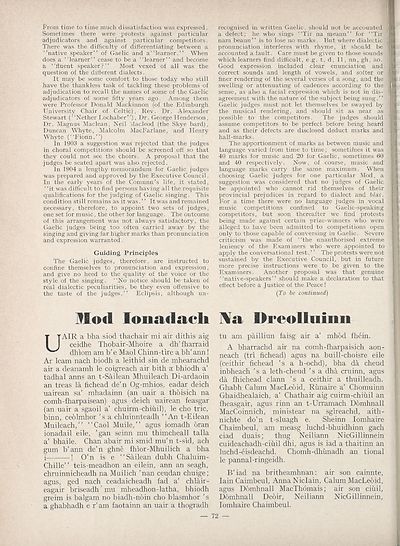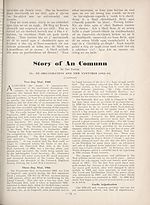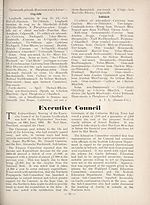An Comunn Gàidhealach Publications > Gaidheal > Volume 49--51, January 1954--December 1956
(326) Page 72
Download files
Complete book:
Individual page:
Thumbnail gallery: Grid view | List view

From time to time much dissatisfaction was expressed.
Sometimes there were protests against particular
adjudicators and against particular competitors.
There was the difficulty of differentiating between a
"native speaker’’ of Gaelic and a'‘learner.’’ When
does a ‘‘learner’’ cease to be a ‘‘learner’’ and become
a ‘ ‘fluent speaker ? ’ ’ Most vexed , of all was the
question of the different dialects.
It may be some comfort to those today who still
have the thankless task of tackling these problems of
adjudication to recall the names of some of the Gaelic
adjudicators of some fifty years ago. Among them
were Professor Donald Mackinnon (of the Edinburgh
University Chair of Celtic), Rev. Dr. Alexander
Stewart (‘ ‘Nether Lochaber’ ’), Dr. George Henderson,
Dr. Magnus Maclean, Neil Macleod (the Skye bard),
Duncan Whyte, Malcolm MacFarlane, and Henry
Whyte (‘‘Fionn.’’)
In 1903 a suggestion was rejected that the judges
in choral competitions should be spreened off so that
they could not see the choirs. A proposal that the
judges be seated apart was also rejected.
In 1904 a lengthy memorandum for Gaelic judges
was prepared and approved by the Executive Council.
In the early years of the Comunn’s life, it stated,
‘ ‘it was difficult to find persons having all the requisite
qualifications for the judging of Gaelic singing. This
condition still remains as it was. ’ ’ It was and remained
necessary, therefore, to appoint two sets of judges,
one set for music, the other for language. The outcome
of this arrangement was not always satisfactory, the
Gaelic judges being too often carried away by the
singing and giving far higher marks than pronunciation
and expression warranted .
Guiding Principles
The Gaelic judges, therefore, are instructed to
confine themselves to pronunciation and expression,
and give no heed to the quality of the voice or the
style of the singing. "No notice should be taken of
real dialectic peculiarities, be they even offensive to
the taste of the judges.’’ Eclipsis, although un¬
recognised in written Gaelic, should not be accounted
a defect; he who sings "Tir na meann’’ for “Tir
nam beann ’ ’ is to lose no marks. But where dialectic
pronunciation interferes with rhyme, it should be
accounted a fault. Care must be given to those sounds
which learners find difficult, e.g. t, d, 11, nn, gh, ao
Good expression included clear enunciation and
correct sounds and length of vowels, and softer or
finer rendering of the several verses of a song, and the
swelling or attenuating of cadences according to the
sense, as also a facial expression which is not in dis
agreement with the nature of the subject being sung.’
Gaelic judges must not let themselves be swayed by
the musical rendering, and should sit as near as
possible to the competitors. The judges should
assume competitors to be perfect before being heard
and as their defects are disclosed deduct marks and
half-marks.
The apportionment of marks as between music and
language varied from time to time; sometifnes it was
40 marks for music and 20 for Gaelic, sometimes 60
and 40 respectively. Now, of course, music and
language marks carry the same maximum. When
choosing Gaelic judges for one particular Mod,
suggestion was considered that no judges of Gaelic
be appointed who cannot rid themselves of thei
provincial prejudices in regard to dialect and bias
For a time there were no language judges in vocal
music competitions confined to Gaelic-speaking
competitors, but soon thereafter we find protests
being made against certain prize-winners who were
alleged to have been admitted to competitions open
only to those capable of conversing in Gaelic. Severe
criticism was made of ‘ ‘the unauthorised extreme
leniency of the Examiners who were appointed to
apply the conversational test. ’ ’ The protests were not
sustained by the Executive Council, but in future
more precise instructions were to be given to the
Examiners. Another proposal was that genuine
‘‘native-speakers’’ should make a declaration to that
effect before a Justice of the Peace!
(To be continued)
Mod lonadacli
UAIR a bha siod thachair mi air dithis aig
ceidhe Thobair-Mhoire a dh’fharraid
dhiom am b’ e Maol Chirm-tire a bh’ arm!
Ar learn nach biodh a leithid sin de mhearachd
air a deanamh le coigreach air bith a bhiodh a’
tadhal anns an t-Sailean Mhuileach Di-ardaoin
an treas la fichead de’n Og-mhios, eadar deich
uairean sa’ mhadainn (an uair a thoisich na
comh-fharpaisean) agus deich uairean feasgar
(an uair a sgaoil a’ chuirm-chiiiil), le cho trie,
binn, ceolmhor ’s a chluinnteadh ‘‘An t-Eilean
Muileach," ‘‘Caol Muile,’’ agus iomadh bran
ionadail eile, ’gan seinn mu thimcheall talla
a’ bhaile. Chan abair mi smid mu’n t-sid, ach
gum b’ann de’n ghne fhior-Mhuilich a bha
i ! O’n is e ‘‘Sailean dubh Chaluim-
Chille’’ teis-meadhon an eilein, ann an seagh,
chruinnicheadh na Muilich 'nan ceudan chuige;
agus, ged nach ceadaicheadh fad a’ chlair-
eagair briseadh ’ mu mheadhon-latha, bhiodh
greim is balgam no biadh-noin cho blasmhor ’s
a ghabhadh e r’ am faotainn an uair a thogradh
\a Dreolliiinn
tu am pailliun faisg air a’ mhod fhein.
A bharrachd air na comh-fharpaisich aon-
neach (trl fichead) agus na buill-choisre eile
(ceithir fichead ’s a h-ochd), bha da cheud
inbheach ’s a leth-cheud ’s a dha cruinn, agus
da fhichead clann ’s a ceithir a thuilleadh.
Ghabh Calum MacLeoid, Runaire a’ Chomuinn
Ghaidhealaich, a’ Chathair aig cuirm-chiiiil an
fheasgair, agus rinn an t-Urramach Domhnall
MacCoinnich, ministear na sgireachd, aith-
nichte do’n t-sluagh e. Sheinn lomhaire
Chaimbeul, am measg luchd-bhuidhinn gach
ciad duais; thug Neiliann NicGillinnein
cuideachadh-ciuil dhi, agus is iad a thaitinn an
luchd-eisdeachd. Chomh-dhimadh an tional
le pannal-ringeidh.
B’iad na britheamhnan: air son cainnte,
Iain Caimbeul, Anna Niclain, Calum MacLeoid,
agus Domhnall MacThomais; air son ciuil,
Domhnall Deoir, Neiliann NicGillinnein,
lomhaire Chaimbeul.
Sometimes there were protests against particular
adjudicators and against particular competitors.
There was the difficulty of differentiating between a
"native speaker’’ of Gaelic and a'‘learner.’’ When
does a ‘‘learner’’ cease to be a ‘‘learner’’ and become
a ‘ ‘fluent speaker ? ’ ’ Most vexed , of all was the
question of the different dialects.
It may be some comfort to those today who still
have the thankless task of tackling these problems of
adjudication to recall the names of some of the Gaelic
adjudicators of some fifty years ago. Among them
were Professor Donald Mackinnon (of the Edinburgh
University Chair of Celtic), Rev. Dr. Alexander
Stewart (‘ ‘Nether Lochaber’ ’), Dr. George Henderson,
Dr. Magnus Maclean, Neil Macleod (the Skye bard),
Duncan Whyte, Malcolm MacFarlane, and Henry
Whyte (‘‘Fionn.’’)
In 1903 a suggestion was rejected that the judges
in choral competitions should be spreened off so that
they could not see the choirs. A proposal that the
judges be seated apart was also rejected.
In 1904 a lengthy memorandum for Gaelic judges
was prepared and approved by the Executive Council.
In the early years of the Comunn’s life, it stated,
‘ ‘it was difficult to find persons having all the requisite
qualifications for the judging of Gaelic singing. This
condition still remains as it was. ’ ’ It was and remained
necessary, therefore, to appoint two sets of judges,
one set for music, the other for language. The outcome
of this arrangement was not always satisfactory, the
Gaelic judges being too often carried away by the
singing and giving far higher marks than pronunciation
and expression warranted .
Guiding Principles
The Gaelic judges, therefore, are instructed to
confine themselves to pronunciation and expression,
and give no heed to the quality of the voice or the
style of the singing. "No notice should be taken of
real dialectic peculiarities, be they even offensive to
the taste of the judges.’’ Eclipsis, although un¬
recognised in written Gaelic, should not be accounted
a defect; he who sings "Tir na meann’’ for “Tir
nam beann ’ ’ is to lose no marks. But where dialectic
pronunciation interferes with rhyme, it should be
accounted a fault. Care must be given to those sounds
which learners find difficult, e.g. t, d, 11, nn, gh, ao
Good expression included clear enunciation and
correct sounds and length of vowels, and softer or
finer rendering of the several verses of a song, and the
swelling or attenuating of cadences according to the
sense, as also a facial expression which is not in dis
agreement with the nature of the subject being sung.’
Gaelic judges must not let themselves be swayed by
the musical rendering, and should sit as near as
possible to the competitors. The judges should
assume competitors to be perfect before being heard
and as their defects are disclosed deduct marks and
half-marks.
The apportionment of marks as between music and
language varied from time to time; sometifnes it was
40 marks for music and 20 for Gaelic, sometimes 60
and 40 respectively. Now, of course, music and
language marks carry the same maximum. When
choosing Gaelic judges for one particular Mod,
suggestion was considered that no judges of Gaelic
be appointed who cannot rid themselves of thei
provincial prejudices in regard to dialect and bias
For a time there were no language judges in vocal
music competitions confined to Gaelic-speaking
competitors, but soon thereafter we find protests
being made against certain prize-winners who were
alleged to have been admitted to competitions open
only to those capable of conversing in Gaelic. Severe
criticism was made of ‘ ‘the unauthorised extreme
leniency of the Examiners who were appointed to
apply the conversational test. ’ ’ The protests were not
sustained by the Executive Council, but in future
more precise instructions were to be given to the
Examiners. Another proposal was that genuine
‘‘native-speakers’’ should make a declaration to that
effect before a Justice of the Peace!
(To be continued)
Mod lonadacli
UAIR a bha siod thachair mi air dithis aig
ceidhe Thobair-Mhoire a dh’fharraid
dhiom am b’ e Maol Chirm-tire a bh’ arm!
Ar learn nach biodh a leithid sin de mhearachd
air a deanamh le coigreach air bith a bhiodh a’
tadhal anns an t-Sailean Mhuileach Di-ardaoin
an treas la fichead de’n Og-mhios, eadar deich
uairean sa’ mhadainn (an uair a thoisich na
comh-fharpaisean) agus deich uairean feasgar
(an uair a sgaoil a’ chuirm-chiiiil), le cho trie,
binn, ceolmhor ’s a chluinnteadh ‘‘An t-Eilean
Muileach," ‘‘Caol Muile,’’ agus iomadh bran
ionadail eile, ’gan seinn mu thimcheall talla
a’ bhaile. Chan abair mi smid mu’n t-sid, ach
gum b’ann de’n ghne fhior-Mhuilich a bha
i ! O’n is e ‘‘Sailean dubh Chaluim-
Chille’’ teis-meadhon an eilein, ann an seagh,
chruinnicheadh na Muilich 'nan ceudan chuige;
agus, ged nach ceadaicheadh fad a’ chlair-
eagair briseadh ’ mu mheadhon-latha, bhiodh
greim is balgam no biadh-noin cho blasmhor ’s
a ghabhadh e r’ am faotainn an uair a thogradh
\a Dreolliiinn
tu am pailliun faisg air a’ mhod fhein.
A bharrachd air na comh-fharpaisich aon-
neach (trl fichead) agus na buill-choisre eile
(ceithir fichead ’s a h-ochd), bha da cheud
inbheach ’s a leth-cheud ’s a dha cruinn, agus
da fhichead clann ’s a ceithir a thuilleadh.
Ghabh Calum MacLeoid, Runaire a’ Chomuinn
Ghaidhealaich, a’ Chathair aig cuirm-chiiiil an
fheasgair, agus rinn an t-Urramach Domhnall
MacCoinnich, ministear na sgireachd, aith-
nichte do’n t-sluagh e. Sheinn lomhaire
Chaimbeul, am measg luchd-bhuidhinn gach
ciad duais; thug Neiliann NicGillinnein
cuideachadh-ciuil dhi, agus is iad a thaitinn an
luchd-eisdeachd. Chomh-dhimadh an tional
le pannal-ringeidh.
B’iad na britheamhnan: air son cainnte,
Iain Caimbeul, Anna Niclain, Calum MacLeoid,
agus Domhnall MacThomais; air son ciuil,
Domhnall Deoir, Neiliann NicGillinnein,
lomhaire Chaimbeul.
Set display mode to:
![]() Universal Viewer |
Universal Viewer | ![]() Mirador |
Large image | Transcription
Mirador |
Large image | Transcription
| An Comunn Gàidhealach > An Comunn Gàidhealach Publications > Gaidheal > Volume 49--51, January 1954--December 1956 > (326) Page 72 |
|---|
| Permanent URL | https://digital.nls.uk/127176333 |
|---|
| Description | This contains items published by An Comunn, which are not specifically Mòd-related. It includes journals, annual reports and corporate documents, policy statements, educational resources and published plays and literature. It is arranged alphabetically by title. |
|---|
| Description | A collection of over 400 items published by An Comunn Gàidhealach, the organisation which promotes Gaelic language and culture and organises the Royal National Mòd. Dating from 1891 up to the present day, the collection includes journals and newspapers, annual reports, educational materials, national Mòd programmes, published Mòd literature and music. |
|---|---|
| Additional NLS resources: |
|

